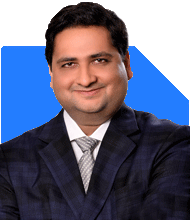Ramalingam Kalirajan |10879 Answers |Ask -Follow
Mutual Funds, Financial Planning Expert - Answered on May 08, 2024
He has an MBA in finance from the University of Madras and is a certified financial planner.
He is the director and chief financial planner at Holistic Investment, a Chennai-based firm that offers financial planning and wealth management advice.... more

Hi Sir I’m 39 Male. I’m investing in MF from start of this year for buying a house and for retirement. I’m planning to invest long for next 15-20 yrs. Also I have 3-4 loans which will get finished next year 2025 end. So I’m planning to start increase my MF amount considerably. Please review my portfolio and let me know if I have to remove, add or make any changes Motilal Oswal Nasdaq 100 fund direct growth 1500 PM UTI Nifty 50 Index Fund 1000 PM ICICI Prudential Bluechip Fund Direct Growth 1000 PM HDFC Balanced Advantage Fund Direct Growth 1000 PM HDFC Midcap Oppurtunities Fund Direct Plan Growth 1000 PM AXIS Small Cap Fund Direct Growth 1000 PM JM Value Fund Direct Growth 1000 PM Parag Parikh Flexi Cap Direct 1000 PM Nippon India Corporate Bond Fund Direct Growth plan 1000 PM P2P investment 3500 PM for 3 yrs at 15% fixed return
1. Motilal Oswal Nasdaq 100 Fund Direct Growth: This fund provides exposure to the top 100 companies listed on the Nasdaq stock exchange, offering diversification and growth potential in the global tech sector. It can be a suitable addition for long-term wealth accumulation.
2. UTI Nifty 50 Index Fund: Investing in an index fund like UTI Nifty 50 offers exposure to the top 50 companies in the Indian equity market. It provides stability and diversification, complementing your other equity investments.
3. ICICI Prudential Bluechip Fund Direct Growth: Bluechip funds focus on large-cap stocks with strong fundamentals, making them relatively less volatile. It's a prudent choice for stability and capital preservation.
4. HDFC Balanced Advantage Fund Direct Growth: This fund dynamically manages its equity exposure based on market conditions, offering a blend of growth and downside protection. It can be suitable for investors seeking a balanced approach.
5. HDFC Midcap Opportunities Fund Direct Plan Growth and AXIS Small Cap Fund Direct Growth: These funds provide exposure to mid-cap and small-cap segments, respectively, offering growth potential but with higher volatility. Ensure you're comfortable with the risk associated with these segments.
6. JM Value Fund Direct Growth and Parag Parikh Flexi Cap Direct: Both these funds follow value investing principles and focus on investing in fundamentally sound companies at reasonable valuations. They can be suitable for long-term wealth creation.
7. Nippon India Corporate Bond Fund Direct Growth: Investing in a corporate bond fund provides stability and income generation through fixed-income securities. It's a prudent choice for diversification and managing risk.
8. P2P Investment: Peer-to-peer lending can offer attractive returns but comes with higher risk compared to traditional investments. Ensure you've assessed the risk-reward profile and have a diversified portfolio to mitigate risks.
Index Funds:
• Index funds offer broad market exposure by tracking a specific index, such as the Nifty 50 or the Nasdaq 100. They provide diversification and low-cost access to the market, making them suitable for long-term investors.
• However, index funds are passively managed, meaning they aim to replicate the performance of the underlying index rather than outperforming it. While this reduces management fees and turnover costs, it also limits the potential for alpha generation.
• As a result, index funds may not capture opportunities for outperformance during market upswings or provide downside protection during downturns. Investors seeking higher returns may prefer actively managed funds that aim to outperform the market through strategic stock selection and portfolio management.
Direct Funds:
• Direct funds allow investors to purchase mutual fund units directly from the asset management company, bypassing intermediaries like distributors or brokers. This can result in lower expense ratios compared to regular funds, as there are no distributor commissions involved.
• However, direct fund investors are responsible for conducting their own research, selecting suitable funds, and monitoring their investments. This requires a certain level of financial literacy and investment expertise to make informed decisions.
• On the other hand, investing through a Certified Financial Planner (CFP) who holds the necessary credentials and expertise can provide valuable guidance and support. A CFP can help investors navigate the complexities of the financial markets, select appropriate investment strategies, and optimize their portfolio allocations based on individual goals and risk tolerance.
Considering your investment portfolio, it's essential to evaluate the role of both index funds and direct funds in achieving your financial objectives. While index funds offer cost-effective market exposure, direct funds provide the potential for active management and outperformance.
As a Certified Financial Planner (CFP), I recommend a balanced approach that incorporates both index funds and direct funds based on your risk profile and investment goals. Periodic reviews of your portfolio and ongoing guidance from a CFP can help ensure that your investment strategy remains aligned with your evolving needs and objectives.
Remember, investing is a journey, and it's essential to stay informed, stay disciplined, and seek professional guidance when needed. With the right approach and support, you can navigate the financial markets with confidence and work towards achieving your long-term financial goals.
You may like to see similar questions and answers below
Hardik Parikh | Answer |Ask -Follow
Tax, Mutual Fund Expert - Answered on Apr 20, 2023
Ramalingam Kalirajan |10879 Answers |Ask -Follow
Mutual Funds, Financial Planning Expert - Answered on May 29, 2024
Ramalingam Kalirajan |10879 Answers |Ask -Follow
Mutual Funds, Financial Planning Expert - Answered on Jul 24, 2024
Milind Vadjikar | Answer |Ask -Follow
Insurance, Stocks, MF, PF Expert - Answered on Oct 11, 2024
Ramalingam Kalirajan |10879 Answers |Ask -Follow
Mutual Funds, Financial Planning Expert - Answered on Mar 25, 2025
Mayank Chandel |2572 Answers |Ask -Follow
IIT-JEE, NEET-UG, SAT, CLAT, CA, CS Exam Expert - Answered on Dec 11, 2025
Mayank Chandel |2572 Answers |Ask -Follow
IIT-JEE, NEET-UG, SAT, CLAT, CA, CS Exam Expert - Answered on Dec 11, 2025
Ramalingam Kalirajan |10879 Answers |Ask -Follow
Mutual Funds, Financial Planning Expert - Answered on Dec 11, 2025
Samraat Jadhav |2507 Answers |Ask -Follow
Stock Market Expert - Answered on Dec 11, 2025
Samraat Jadhav |2507 Answers |Ask -Follow
Stock Market Expert - Answered on Dec 11, 2025
Samraat Jadhav |2507 Answers |Ask -Follow
Stock Market Expert - Answered on Dec 11, 2025
Samraat Jadhav |2507 Answers |Ask -Follow
Stock Market Expert - Answered on Dec 11, 2025
Dr Nagarajan J S K |2577 Answers |Ask -Follow
NEET, Medical, Pharmacy Careers - Answered on Dec 10, 2025
Mayank Chandel |2572 Answers |Ask -Follow
IIT-JEE, NEET-UG, SAT, CLAT, CA, CS Exam Expert - Answered on Dec 10, 2025
Samraat Jadhav |2507 Answers |Ask -Follow
Stock Market Expert - Answered on Dec 10, 2025


























